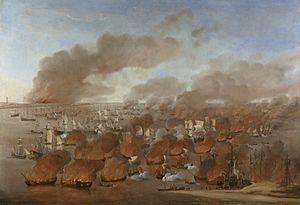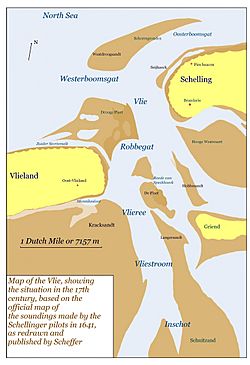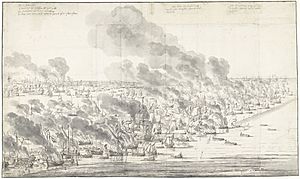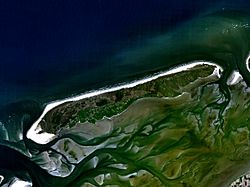Holmes's Bonfire facts for kids
Quick facts for kids Holmes's Bonfire |
|||||||
|---|---|---|---|---|---|---|---|
| Part of the Second Anglo-Dutch War | |||||||
 'Holmes's Bonfire' by Willem van de Velde the Elder |
|||||||
|
|||||||
| Belligerents | |||||||
| Commanders and leaders | |||||||
| Robert Holmes | |||||||
| Strength | |||||||
| 8 ships | 2 ships 150 merchant vessels |
||||||
| Casualties and losses | |||||||
| 6 killed 24 wounded |
2 ships destroyed 140 merchant vessels destroyed |
||||||
Holmes's Bonfire was a big attack by the English Navy. It happened during the Second Anglo-Dutch War. The attack took place on August 19 and 20, 1666. It was in the Vlie estuary in the Netherlands.
The raid is named after its leader, Rear-Admiral Robert Holmes. The English successfully burned 140 merchant ships. They also burned down the town of West-Terschelling. This made the Dutch Republic very angry.
Contents
Why the English Attacked
After a big win in the St James's Day Battle, the English Navy controlled the North Sea. The Dutch fleet was damaged and couldn't fight for a while. English commanders George Monck, 1st Duke of Albemarle and Prince Rupert of the Rhine wanted to use this chance.
They needed to attack a Dutch port quickly. The English fleet was running low on supplies. They would soon have to go home. Many Dutch ports were too strong or too far inland.
Finding a Target: The Vlie Estuary
The port of Harlingen was a good target. It was part of the Waddenzee. This area has many mudflats and islands. The main way to the North Sea from Harlingen was the Vlie estuary. This is between the islands of Vlieland and Terschelling.
Many merchant ships used the Vlie as a safe place. They were waiting there to sail to the Baltic. People thought the shallow waters would protect them. But the English had help from a Dutch captain named Laurens Heemskerck. He knew the area well.
Preparing for the Raid
The English put together a special landing force. It had 300 men from each of their three squadrons. Two-thirds were sailors, and one-third were soldiers. Eight frigates (warships) were chosen for the mission.
- Advice (46 cannons)
- Hampshire (40 cannons)
- Tyger (40 cannons)
- Dragon (40 cannons)
- Assurance (36 cannons)
- Sweepstake (36 cannons)
- Garland (28 cannons)
- Pembroke (28 cannons)
They also had five fireships and seven ketches. Thirty-six small boats called sloops were also ready. Rear-Admiral Robert Holmes was in charge. His main goal was to take things from the islands. Burning Dutch ships was a secondary goal.
The Attack Begins
On August 19, Holmes sailed into the Vlie. He used the Tyger as his main ship. He had a new pilot who knew the channels. They found about 140 merchant ships anchored there. Two Dutch frigates, the Vollenhove and the Middelhoven, guarded them.
The Dutch crews felt safe. Many islanders had even brought their valuables onto the ships. They thought their ships were safer than their homes.
Burning the Dutch Fleet
Holmes first thought about attacking Vlieland island. But he saw it was mostly empty dunes. He decided to attack the large fleet of merchant ships instead. This fleet had thousands of sailors.
Around 1:00 PM, five English fireships attacked. They sailed into the main channel where the merchant fleet was. The attack was a huge success. The first fireship set the Dutch frigate Vollenhove on fire. Many Dutch sailors drowned trying to escape.
The second fireship approached the Middelhoven. Its crew quickly left the ship. English sailors then boarded and burned the Middelhoven. The other three fireships burned more large Dutch merchant ships. This caused a huge panic.
Holmes quickly sent out demolition teams in sloops. They set fire to any ship they could reach. The strong wind pushed burning ships into others. This made it easier for the English. By 8:00 PM, about 130 ships were destroyed. Only about eleven ships escaped.
Most sailors saved themselves by rowing to Harlingen. Some walked across sandbanks to Vlieland. The English didn't take many prisoners. They didn't have enough money to feed them. Some historians believe about two thousand people died.
Meanwhile, the local people on Vlieland tried to fight back. But seeing the huge fires, they lost hope. Most of them fled.
Burning Terschelling Town
On the evening of August 19, Holmes realized his mistake. The main buildings and warehouses were on Terschelling island. The town there was called 'ter Schelling'. Today it is known as West-Terschelling. The English knew it as Brandaris, after its tall lighthouse.
Terschelling was a rich town. It was a main base for Dutch whaling. It had many warehouses, some for the Dutch East India Company. The town had about 400 stone houses but no walls. Many people living there were pacifists.
At 5:00 AM on August 20, Holmes ordered an attack on the town. A few armed men tried to stop them. But six English companies landed. They marched into the town. Most of the people had already fled.
The Town in Flames
English soldiers began to take things and burn houses. Holmes ordered some houses on the east side to be set on fire. This was to make his men stop looting and leave quickly. It had been a very dry summer.
Within hours, almost the entire town burned down. Only about thirty houses, the town hall, a church, and the Brandaris lighthouse were saved. The English troops left in good order.
As Holmes returned to his ship, he learned that Prince Rupert had ordered him to leave. This prevented a fight with Dutch reinforcements. The famous naval painter Willem van de Velde the Elder was with the Dutch troops. He made sketches of the burning town. These sketches later became dramatic paintings.
After the Attack
On August 21, Holmes reported his success. He said he destroyed about 150 ships. He also captured a ship and destroyed Terschelling. All this cost the English only six dead and a few wounded.
The news of the attack reached England. People were very happy. King Charles II of England ordered bonfires to be lit. This was a common way to celebrate victories. People started calling the event "Holmes's Bonfire."
Dutch Reaction and Revenge
In the Dutch Republic, the attack caused anger. The stock market in Amsterdam crashed. People were upset that a fleet worth a lot of money was lost. The Dutch leader, Grand Pensionary Johan de Witt, used this anger. He focused on how cruel the burning of Terschelling was.
The Dutch and English usually didn't attack each other's towns. Burning an entire town was seen as a betrayal. Many pamphlets were written about the "Sack of ter Schelling." They described terrible things the English supposedly did. In reality, few civilians died.
Three weeks later, the Great Fire of London happened. The Dutch saw this as God's punishment for the English. They believed London burned because Charles II celebrated the destruction of Terschelling.
The English later felt the raid didn't help them much. While many Dutch ships were destroyed, it wasn't a fatal blow to their trade. No major prizes were taken. The burning of Terschelling was seen as a foolish act. It could lead to the Dutch attacking English coastal towns.
The Dutch people were determined to continue the war. They started rebuilding Terschelling. Many towns and churches helped raise money. The Great Fire of London made them feel God had already gotten revenge.
However, the anger from Holmes's Bonfire was still there. The next year, the Dutch launched a devastating attack. This was the Raid on the Medway. They attacked the English naval base at Chatham Dockyard. During this raid, the Dutch had strict orders not to harm civilians or their property. This was to shame the English.
The Legend of the Stryper Wyfke
The burning of Terschelling is remembered in a famous legend. It's about the Stryper Wyfke, or "Little Wife of Stryp." The story says that people fleeing the English were saved by an old woman. She was near a hamlet called Stryp.
Some English soldiers saw old gravestones in a fog. They thought they were Dutch troops. They asked the old woman how many soldiers there were. She replied, "Hundreds of them are standing, but thousands are lying." She was talking about the buried bodies. The English soldiers got scared and left.
Today, a bronze statue of the Stryper Wyfke stands west of Midsland. It shows her pointing to the graveyard.






